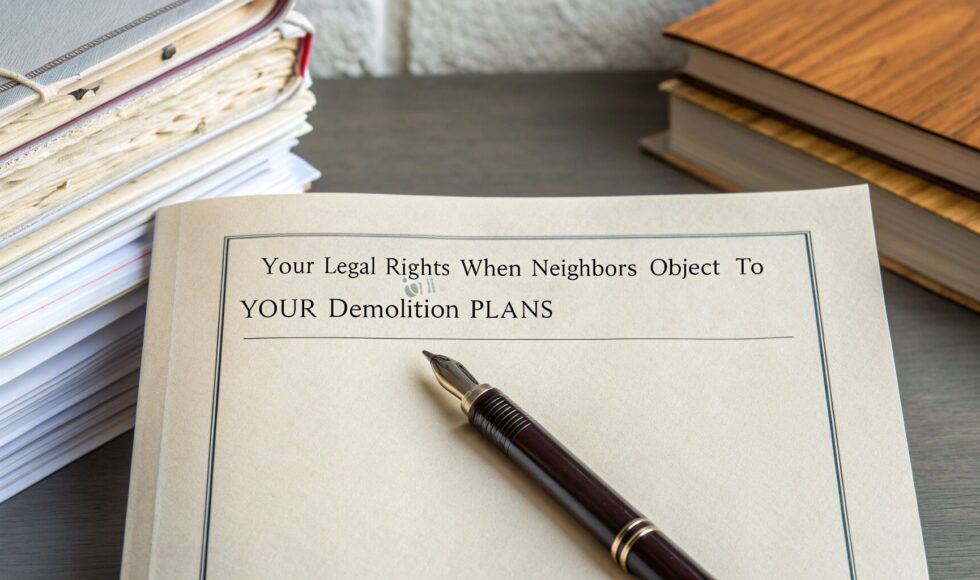So, you’ve finally decided to take the plunge! That tired old Queenslander or dated brick veneer is making way for your dream home. You’ve got the vision, maybe even the plans pinned up on the fridge. Feels exciting, right? Then… the neighbours catch wind of it. Maybe it’s a concerned chat over the fence, a formal letter, or even whispers of a petition doing the rounds. Suddenly, that dream feels tangled up in anxiety and frustration. Before things escalate into a full-blown neighbourhood drama, let’s grab a cuppa and talk calmly about what your legal rights actually are here in Australia when neighbours raise objections to your demolition plans. Knowledge really is your best tool (and stress reliever!) in this situation.
Your Core Rights When Neighbors Object
When those objection letters land on the council desk, here’s the legal footing you stand on:
A Fair Go from Council
This is the big one. The council has to look at your demolition application (and any rebuild plans) properly. They can’t just chuck it out because Mrs. Jones next door is unhappy. Their decision must be based on the actual planning rules – your council’s Local Environmental Plan (LEP), their Development Control Plan (DCP), and state policies. They need solid reasons grounded in these documents. Think things like: “Will this block too much winter sun from the neighbour’s veggie patch?” or “Does it sit too close to the boundary?” or “Will the construction traffic cause chaos on our quiet cul-de-sac?” or “Is there a heritage angle we missed?”.
Knowing What’s Being Said
You have the right to see what the objections actually are. The council will usually send you copies of everything submitted during the public comment period. Don’t skip reading these! Understanding the specific worries is half the battle in figuring out how to respond.
Your Chance to Have Your Say (Properly!)
This is absolutely crucial. You have the right to formally respond to the council about every point raised. This isn’t about having a blue over the back fence; it’s about calmly and clearly addressing concerns with facts and planning arguments. Your response might involve:
- Clearing up any misunderstandings about what you’re actually planning to build.
- Getting experts involved – like a noise specialist to show how you’ll manage the racket, or a soil engineer to prove the dig won’t undermine the next door’s patio.
- Demonstrating point-by-point how your plans do fit within the council’s rulebook.
- Offering sensible compromises – maybe adjusting work hours, committing to top-notch dust control, or tweaking where the trucks enter the site. A little flexibility early on can save mountains of hassle later.
Think of it as smart tactical asset management for your sanity and your project.
A Decision Based on Facts, Not Feelings
The council’s final call must be based on the planning rules, the evidence (including the objections and your detailed response), and the law. It shouldn’t come down to who’s more popular at the local BBQ.
What Your Rights Don’t Cover (Let’s Be Real)
Knowing the limits is just as important:
Brushing Off Legit Concerns
Ignoring neighbours’ valid worries (like genuine overshadowing or potential damage) isn’t just rude, it’s strategically dumb. It weakens your position with the council. Listen first.
A Guaranteed Green Light
Even if your plans tick every technical box, council approval isn’t automatic. Councils have some wiggle room to consider the overall impact on the neighbourhood. There’s no magic “compliance = approval” rule.
Getting Narky or Nasty
Losing your cool, making threats, or hassling objecting neighbours is a surefire way to make everything worse. It could even land you in hot water with things like nuisance claims or intervention orders. Keep it professional, always.
Just Going For It
Starting the demolition without council approval is illegal. Full stop. Expect a swift Stop Work Order, potentially massive fines, and a world of pain for any future applications. Don’t risk it.
Okay, Rights Understood. Now, How Do You Handle This?

Knowing your rights is step one. Making them work for you is where the real skill comes in:
Get Ahead of the Game (Seriously, Do This!)
Don’t wait for the avalanche. Before you even lodge the paperwork, have a friendly, casual yarn with your immediate neighbours. Explain what you’re planning, roughly how long it might take, and – crucially – what steps you’ll take to keep the disruption down (think noise limits, dust suppression, tidy site management). This simple act of respect can turn potential opponents into understanding allies, or at least soften the blow. A quick chat over the fence is worth its weight in gold later.
Build Your A-Team
Don’t try to wing this alone.
- A Good Town Planner: Worth their weight in gold bricks. They speak fluent council-ese, know how to present your case effectively, and are ninjas at navigating objections and crafting responses. They’re your translator and strategist.
- A Planning Lawyer (If Things Get Rocky): If objections are complex, numerous, or you smell a refusal coming, get legal advice early. They’re your champions if you end up at tribunal.
- Your Designer/Architect: They can ensure your design minimises neighbour impacts from the get-go (smaller footprint? Better window placement? Clever screening?) and can tweak things if needed to ease concerns.
Decode the Objections
Sit down with your planner and go through every single objection. Sort them out:
- The “Not a Fan” Brigade: “We liked the old house,” “Change is scary.” Annoying? Sure. Legally relevant? Usually not.
- The “My Property Value!” Worry: Super common, but generally not something council can legally consider when making its planning decision. It’s a market thing, not a planning rule.
- The Real Planning Gripes: “This second story will put my lounge in permanent shade from 2pm onwards, breaking the solar access rules.” These are the ones you need to tackle head-on with facts and solutions in your response.
Craft Your Comeback (The Smart Way)
Your formal response to the council, guided by your planner (and maybe a good lawyer), is your key weapon. Make it:
- Calm, professional, and packed with facts – leave the emotion at the door.
- Clearly linked to the specific council rules you’re meeting.
- Directly addressing the real planning concerns, backed by expert reports or plan tweaks.
- Clearly separating genuine issues from personal opinions or irrelevant fears.
- Offering practical fixes or conditions you’d accept to make things work (e.g., “We agree to construction hours of 7am-5pm Mon-Fri, 8am-1pm Sat”).
Expect Some Strings Attached
Council might approve your demo (and rebuild) but add conditions to soothe neighbour worries. This could mean strict work hours, super-duper dust control, vibration monitors, or protecting that prized lemon tree next door. Factor these potential extras into your budget and timeline – they’re often just the cost of getting it done. Opting for a full knock down rebuild project? Get ready for even more neighbourly attention. It’s a bigger disruption (longer, messier, noisier) and results in a completely new house changing the street. Double down on making sure your new design meticulously follows all the current rules (height, setbacks, privacy, floor space).
Beyond the Law: Community Smarts
While the law gives you a framework, navigating this successfully often comes down to balancing your rights with a bit of old-fashioned neighbourly consideration and clear communication. Remember, you’re not just building a house; you’re becoming part of a community for the long haul. A little empathy and openness can go a surprisingly long way in smoothing the path.
Facing neighbour objections when you’re just trying to build your dream home is tough. It can feel incredibly personal and stressful. But understanding your legal rights – to a fair hearing, to know the concerns, to respond properly, and to challenge unfair decisions – gives you solid ground to stand on. Remember, council has to follow the planning rulebook, not just count objection letters.

